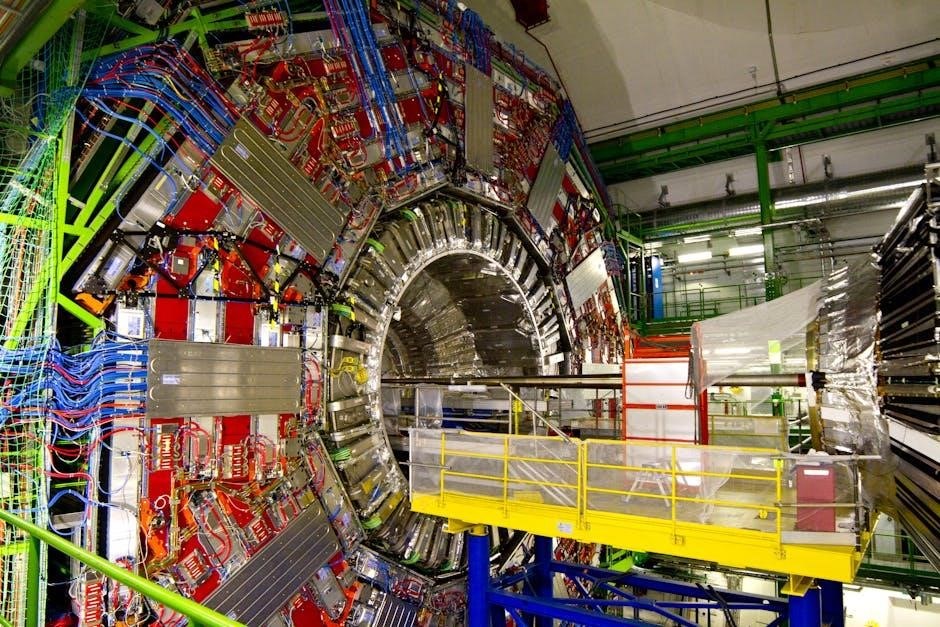This best-selling classic provides a graduate-level, non-historical introduction to quantum mechanics, offering a modern and comprehensive understanding of the subject for advanced students and researchers.
1.1 Overview of the Book
Modern Quantum Mechanics by J.J. Sakurai is a renowned graduate-level textbook that provides a modern, non-historical introduction to quantum mechanical concepts. The book is structured to offer a comprehensive understanding of the subject, focusing on clarity and depth. It avoids historical narratives, instead emphasizing a logical progression of ideas. The text covers fundamental principles, mathematical frameworks, and advanced topics, making it a cornerstone for graduate students and researchers. Revised by Jim Napolitano, the second edition includes updated content and extensions to modern applications. The book’s clear exposition and rigorous approach have made it a popular choice for those seeking a deep understanding of quantum mechanics. Its accessibility and thoroughness ensure it remains a vital resource in the field.
1.2 Importance of the PDF Version
The PDF version of Sakurai Quantum Mechanics is highly valued for its accessibility and convenience. It allows readers to access the content on various devices, making it ideal for study and research. The PDF format ensures that the book’s complex equations and diagrams are preserved with clarity. This digital version is particularly useful for graduate students and researchers who require quick access to information. Additionally, the PDF is widely available online, enabling global access to this authoritative text. Its portability and searchability make it a preferred choice for those engaging with advanced quantum mechanics. The PDF version has become an essential resource for modern physicists due to its ease of use and comprehensive coverage of the subject.

Key Features of “Modern Quantum Mechanics” by J.J. Sakurai
This graduate-level textbook offers a clear, modern, and non-historical introduction to quantum mechanics, integrating classical and quantum concepts with mathematical rigor, making it ideal for advanced students and researchers.
J.J. Sakurai’s Modern Quantum Mechanics provides a best-selling, graduate-level introduction to the subject, designed for advanced students and researchers. The text offers a modern, non-historical approach, focusing on clarity and depth in presenting quantum mechanical concepts. It bridges the gap between undergraduate and advanced topics, making it accessible to those transitioning to higher-level studies. The book emphasizes the integration of classical mechanics with quantum principles, offering a comprehensive framework for understanding the subject. With clear explanations and logical structure, it prepares students for research and professional applications. Its graduate-level problems and solutions manual further enhance its value as a teaching tool. This text is widely regarded as a standard reference in quantum mechanics education.
2.2 Non-Historical Approach to Quantum Mechanical Concepts
Modern Quantum Mechanics by J.J. Sakurai adopts a non-historical approach, focusing on the essential principles and modern applications of quantum mechanics. This method avoids unnecessary historical narratives, allowing readers to delve directly into the core concepts. The text emphasizes practical relevance and theoretical clarity, making it ideal for graduate students seeking a contemporary understanding of quantum principles. By skipping traditional historical developments, the book streamlines the learning process, ensuring that students grasp the subject’s foundational ideas efficiently. This approach also facilitates a smoother transition to advanced topics and their applications in particle physics and quantum computing, aligning with current research trends. The non-historical structure ensures the material remains focused and aligned with the needs of modern physicists.
2.3 Integration of Classical Mechanics and Quantum Mechanics
Modern Quantum Mechanics uniquely bridges classical and quantum mechanics, providing a cohesive understanding of how these two frameworks interrelate. Sakurai emphasizes the importance of classical mechanics as a foundation for quantum principles, ensuring a smooth transition for learners. The text explores how quantum concepts extend classical ideas, particularly in areas like angular momentum and harmonic oscillators. This integration helps students appreciate the logical progression from classical to quantum theories, enhancing their ability to tackle advanced problems. By connecting these traditionally separate fields, the book offers a holistic view of physical phenomena, making it invaluable for graduate-level studies and research in modern physics.

Editions of the Book
The second edition (2010) and the revised third edition, updated by Jim Napolitano, are widely recognized for their clarity and modern approach to quantum mechanics.
3.1 Second Edition (2010)
The second edition of “Modern Quantum Mechanics” by J.J. Sakurai and Jim Napolitano, published in 2010 by Addison-Wesley, is a highly acclaimed graduate-level textbook; It provides a non-historical, modern introduction to quantum mechanics, emphasizing clarity and depth. The book is known for its rigorous mathematical approach and its ability to bridge classical and quantum concepts seamlessly. The second edition builds on the original work, refining explanations and incorporating contemporary developments in the field. Its structured format and comprehensive coverage make it a favorite among graduate students and researchers. This edition is particularly praised for its clear outline of postulates and its focus on the observer’s role in quantum mechanics, ensuring a solid foundation for advanced studies. It remains a cornerstone in quantum mechanics education and research.
3.2 Revised Third Edition by Jim Napolitano
The revised third edition of “Modern Quantum Mechanics,” edited by Jim Napolitano, builds on the legacy of J.J. Sakurai’s original work. This edition introduces new topics and expands on existing ones, ensuring the text remains relevant and comprehensive for contemporary studies. Napolitano’s revisions maintain the book’s hallmark clarity and mathematical rigor while incorporating modern developments in quantum mechanics. The third edition is particularly noted for its enhanced explanations of key concepts and its inclusion of supplementary material, making it accessible to a broader audience of graduate students and researchers. This edition continues to solidify the book’s reputation as a foundational resource in quantum mechanics education and research, blending tradition with innovation.

Author Background
J.J. Sakurai was a prominent theorist in particle physics, known for his contributions to quantum mechanics and education. His work remains highly influential in modern physics research.
4.1 J.J. Sakurai: Renowned Theorist in Particle Theory
J.J. Sakurai was a distinguished physicist recognized for his significant contributions to particle theory and quantum mechanics. His work laid the foundation for modern theoretical physics, particularly in the realm of quantum field theory and particle physics. Sakurai’s research and teaching career spanned several decades, during which he authored numerous influential papers and textbooks. His ability to bridge complex theoretical concepts with accessible explanations made him a respected figure in academia. The second edition of his book, revised by Jim Napolitano, continues to be a cornerstone in graduate-level quantum mechanics education, reflecting his enduring legacy in the field.
4.2 Contributions to Quantum Mechanics
J.J. Sakurai’s contributions to quantum mechanics are profoundly evident in his seminal textbook, which has become a cornerstone of graduate-level education. The second edition, revised by Jim Napolitano, expands on Sakurai’s original work, introducing modern topics such as quantum computing and advanced experimental techniques. His approach emphasizes clarity and rigor, making complex concepts accessible to students and researchers alike. Sakurai’s work bridges classical and quantum mechanics, providing a unified framework that has influenced both academic and industrial applications. His legacy continues to inspire new generations, solidifying his impact on the field of quantum mechanics and beyond.

Postulates of Quantum Mechanics in Sakurai’s Work
Sakurai’s work presents the postulates of quantum mechanics with exceptional clarity, providing a robust foundation for understanding the principles of wave functions and measurement processes.
5.1 Clear Outline of Postulates
Sakurai’s work excels in presenting the postulates of quantum mechanics with remarkable clarity and precision. The text provides a logical structure, beginning with the fundamental principles of wave functions and their probabilistic interpretations. It emphasizes the role of operators in representing observable quantities, ensuring a clear connection between theory and measurement. The postulates are outlined in a manner that builds a strong theoretical foundation, making the concepts accessible to graduate-level students. The approach avoids unnecessary complexity, focusing on essential ideas that form the core of quantum mechanics. This clarity enables readers to grasp the underlying principles effortlessly, fostering a deep understanding of the subject’s mathematical and conceptual framework.

5.2 Role of Observers in Quantum Mechanics
Sakurai’s work emphasizes the significance of observers in quantum mechanics, integrating their role seamlessly with classical mechanics and relativity. The text highlights how observers construct measurements, linking theoretical frameworks to experimental practices. By addressing the observer’s role, Sakurai provides clarity on the transition from quantum states to measurable outcomes, avoiding interpretational confusion. This approach ensures a coherent understanding of quantum mechanics, bridging theory and observation effectively for graduate-level students and researchers alike.

Mathematical Foundations
Sakurai’s text establishes a robust mathematical framework, emphasizing Hilbert space and operator theory, providing rigorous tools for understanding quantum mechanics’ theoretical underpinnings and applications.
6.1 Hilbert Space and Operators
Sakurai’s “Modern Quantum Mechanics” heavily relies on the mathematical framework of Hilbert spaces and operators, which are central to quantum theory. Hilbert spaces provide the structure for state vectors, enabling the description of quantum states. Operators, representing observables, act on these states, linking abstract mathematics to physical measurements. Sakurai emphasizes the importance of linear operators in transforming states and extracting information about system properties. The text rigorously develops the formalism, ensuring a deep understanding of the underlying principles. This foundation is crucial for tackling advanced topics in quantum mechanics, making it indispensable for graduate-level studies and research.
6.2 Mathematical Rigor in Sakurai’s Approach
Sakurai’s “Modern Quantum Mechanics” is renowned for its mathematical rigor, providing a robust foundation for understanding quantum theory. The text meticulously develops concepts with precise derivations and logical structure, ensuring clarity and depth. Sakurai emphasizes the importance of mathematical precision, particularly in the formulation of quantum mechanical principles. The book balances abstract mathematical formalism with physical intuition, making it accessible while maintaining academic rigor. This approach equips students with the tools necessary for advanced research and problem-solving in quantum mechanics. The mathematical depth and clarity make Sakurai’s work a cornerstone for graduate-level studies, offering a comprehensive framework for exploring complex quantum systems and phenomena.

Applications of Sakurai’s Quantum Mechanics
Sakurai’s work applies to quantum computing, particle physics, and modern experimental techniques, bridging theoretical foundations with practical advancements in these cutting-edge fields of physics and technology.
7.1 Quantum Computing and Information
Quantum computing and information are rapidly advancing fields where Sakurai’s work provides foundational insights. His formulation of quantum mechanics, particularly in Hilbert space and operator theory, is crucial for understanding qubits and quantum gates. The principles outlined in his text, such as superposition and entanglement, form the backbone of quantum algorithms. Researchers and students alike rely on Sakurai’s clear explanations to explore quantum information theory, including quantum cryptography and error correction. The mathematical rigor in his approach ensures a solid understanding of quantum systems, enabling advancements in quantum computing hardware and software. This connection underscores the relevance of Sakurai’s work in modern quantum computing advancements.
7.2 Particle Physics and Relativity
Sakurai’s work significantly influences particle physics and relativity, particularly through his contributions to quantum field theory and relativistic quantum mechanics. His non-historical approach clarifies modern concepts, enabling deeper understanding of particle interactions and high-energy phenomena. The revised third edition, updated by Jim Napolitano, incorporates advancements in particle physics, aligning with contemporary research. Sakurai’s mathematical rigor bridges quantum mechanics and relativity, essential for studying phenomena like particle creation and annihilation. Applications in high-energy physics and cosmology rely on his formulations. The text’s emphasis on relativistic wave equations and symmetries provides a robust framework for exploring particle dynamics, making it a vital resource for researchers in these fields. Its insights continue to shape modern particle physics and relativistic quantum theories.
7.3 Modern Experimental Techniques
Sakurai’s text supports modern experimental techniques in quantum mechanics, offering foundational theories that underpin cutting-edge research. The book’s emphasis on Hilbert spaces and operators aligns with advanced experimental methods, such as quantum computing and information processing. Researchers use Sakurai’s formulations to interpret experimental data in particle physics and quantum optics. The integration of classical and quantum mechanics provides a framework for understanding modern tools like interferometers and spectroscopes. Additionally, the text’s focus on mathematical rigor aids in the development of precise experimental setups, ensuring accuracy in measurements. This connection between theory and practice makes Sakurai’s work indispensable for experimental physicists seeking to explore quantum phenomena. The revised editions further enhance this by incorporating recent advancements, bridging theory with contemporary experimental demands. The book thus serves as both a theoretical guide and a practical resource for modern experimental techniques in quantum mechanics.

Study Resources and Supplements
The book is complemented by a solutions manual and graduate-level problems, providing students with additional resources to master quantum mechanics concepts and applications effectively.
8.1 Solutions Manual for Problems
The Solutions Manual for Problems in “Sakurai Quantum Mechanics PDF” is an invaluable resource for students, providing detailed solutions to the graduate-level problems presented in the text. Designed to complement the main book, it helps students master complex quantum mechanics concepts through worked-out examples. The manual covers a wide range of topics, from foundational principles to advanced applications, ensuring a deep understanding of the subject. By working through the problems and referring to the solutions, students can reinforce their theoretical knowledge and improve their problem-solving skills. This resource is particularly beneficial for graduate students and researchers seeking to apply quantum mechanics in their studies and work. It serves as a bridge between theory and practical application, making it an essential companion for anyone using Sakurai’s text.
8.2 Homework and Graduate-Level Problems
The homework and graduate-level problems in “Sakurai Quantum Mechanics PDF” are designed to challenge students and deepen their understanding of quantum mechanics. These problems cover a wide range of topics, from foundational principles to advanced applications, ensuring comprehensive learning. They require students to apply theoretical concepts to practical scenarios, fostering critical thinking and problem-solving skills. The problems are academically rigorous, making them suitable for graduate-level studies and research. By engaging with these exercises, students can bridge the gap between theory and application, enhancing their mastery of quantum mechanics. These problems are an essential component of the learning process, preparing students for advanced research and practical challenges in the field.

Legacy and Impact
J.J. Sakurai’s “Modern Quantum Mechanics” has profoundly influenced quantum mechanics education and research, becoming a standard reference for graduate students and researchers worldwide, shaping modern physics.
9.1 Influence on Academic and Industrial Applications
J.J. Sakurai’s “Modern Quantum Mechanics” has had a profound impact on both academic and industrial applications. Its clear and rigorous presentation of quantum mechanical concepts has made it a cornerstone for research in particle physics, quantum computing, and materials science. The book’s emphasis on the integration of classical and quantum mechanics has inspired advancements in experimental techniques and theoretical frameworks. In industry, the principles outlined in the text are applied in the development of quantum technologies, semiconductor devices, and advanced instrumentation. Researchers and engineers rely on Sakurai’s work to bridge the gap between theoretical understanding and practical implementation, making it an indispensable resource for cutting-edge scientific and technological progress.
9.2 Popularity Among Graduate Students and Researchers
J.J. Sakurai’s “Modern Quantum Mechanics” remains a favorite among graduate students and researchers due to its clarity, rigor, and modern approach. Its non-historical presentation and comprehensive coverage of quantum mechanical concepts make it indispensable for advanced studies. The book’s logical structure and clear postulates provide a solid foundation for understanding complex theories. Researchers appreciate its depth and relevance to cutting-edge fields like quantum computing and particle physics. The revised editions, particularly the third edition by Jim Napolitano, have further enhanced its appeal by incorporating contemporary topics. This text is widely adopted in graduate-level courses and is often praised for its ability to bridge the gap between theory and practical applications, making it a cornerstone of modern quantum mechanics education and research.
J.J. Sakurai’s “Modern Quantum Mechanics” is a seminal text that bridges theory and application, inspiring further exploration in quantum mechanics for students and researchers alike.
10.1 Summary of Key Concepts
J.J. Sakurai’s Modern Quantum Mechanics provides a comprehensive graduate-level introduction to quantum mechanics, emphasizing a non-historical, modern approach. The text establishes a robust foundation with clear postulates, integrating classical and quantum principles seamlessly. It explores advanced topics such as Hilbert spaces, operators, and the role of observers, while maintaining mathematical rigor. Applications in quantum computing, particle physics, and experimental techniques highlight the book’s relevance to contemporary research. The revised editions, including contributions by Jim Napolitano, expand its scope, making it a vital resource for both academic and industrial applications. The text’s clarity and depth have solidified its status as a cornerstone in quantum mechanics education and research.
10.2 Encouragement for Further Study
For those eager to delve deeper into quantum mechanics, Modern Quantum Mechanics serves as an excellent foundation. The book’s clear postulates and rigorous mathematical framework provide a solid base for exploring advanced topics in quantum computing, particle physics, and experimental techniques. Supplementary resources like the solutions manual and graduate-level problems further enhance understanding. Students are encouraged to engage with the broader academic community, where discussions and research continue to evolve the field. The legacy of J.J. Sakurai’s work inspires scholars to pursue innovative applications, ensuring that the study of quantum mechanics remains a vibrant and dynamic area of exploration.
